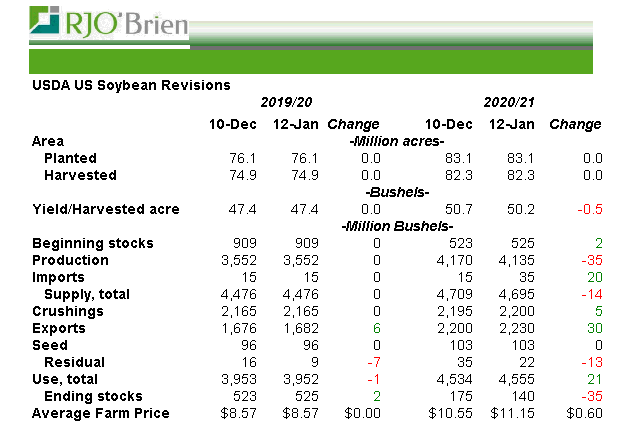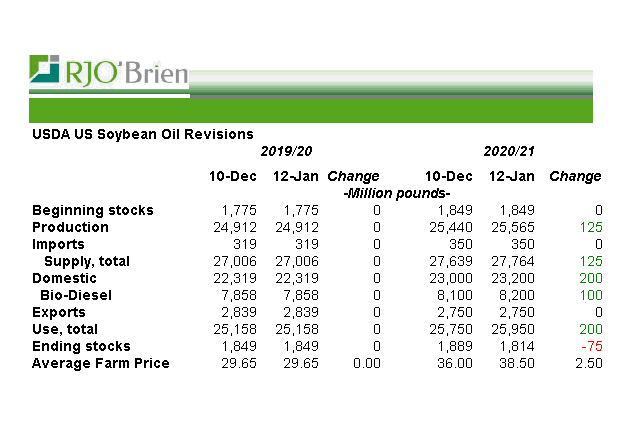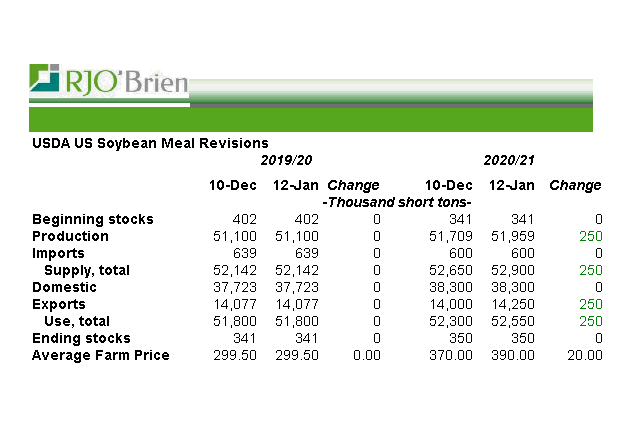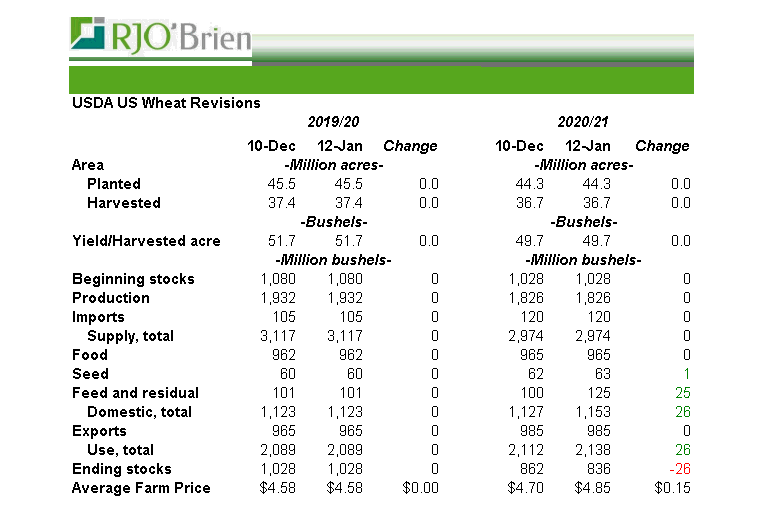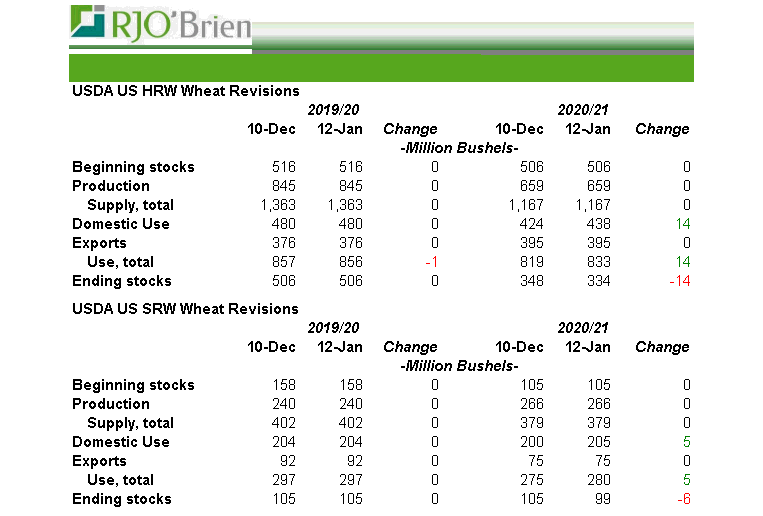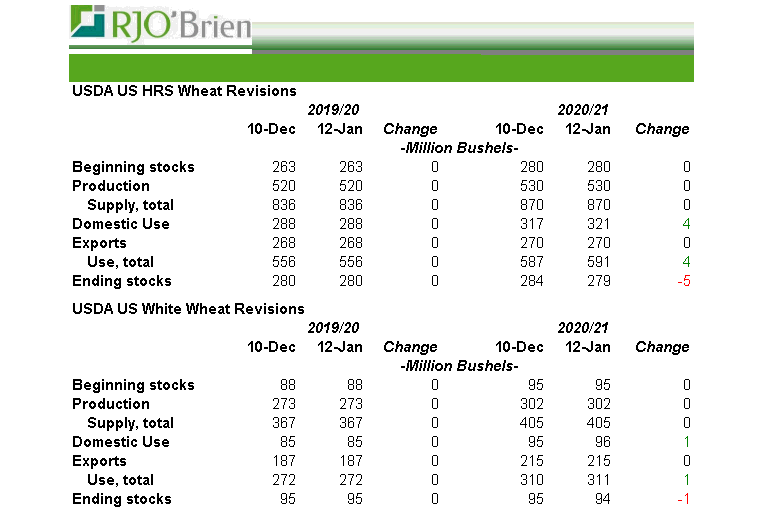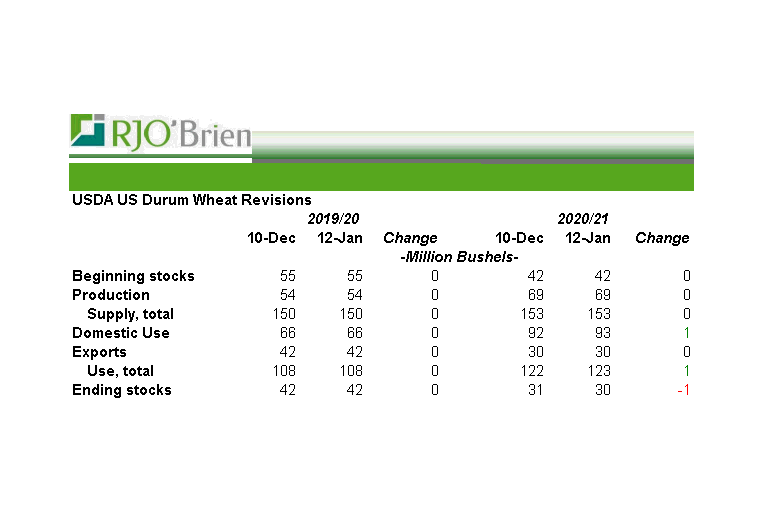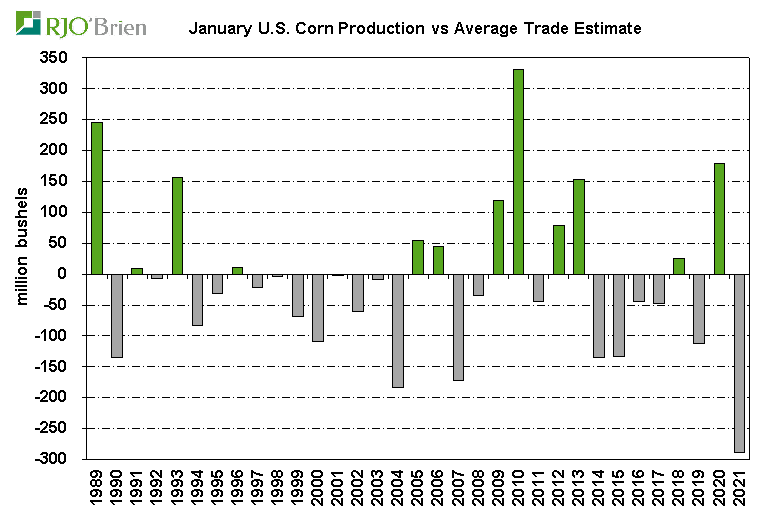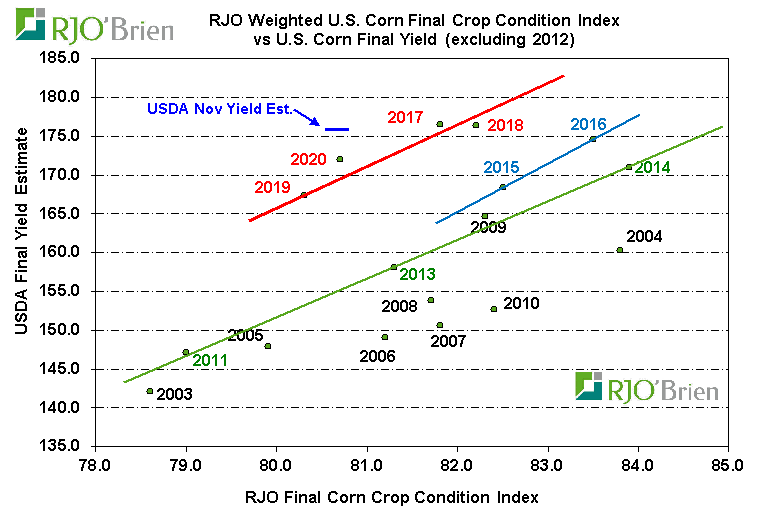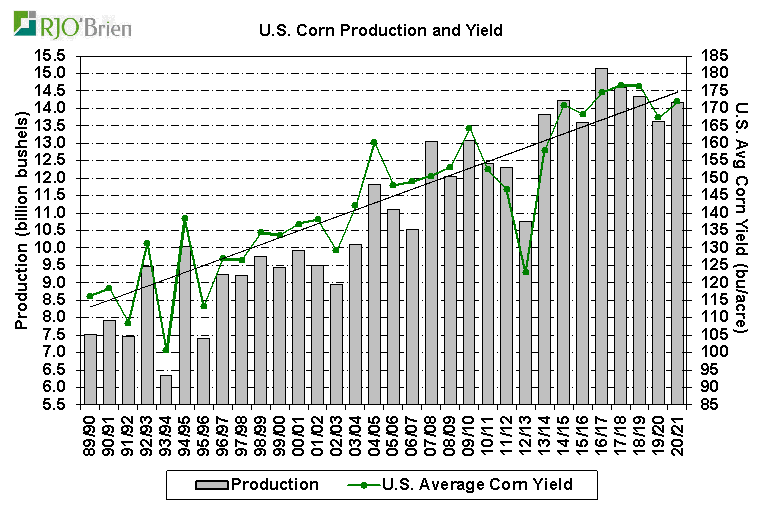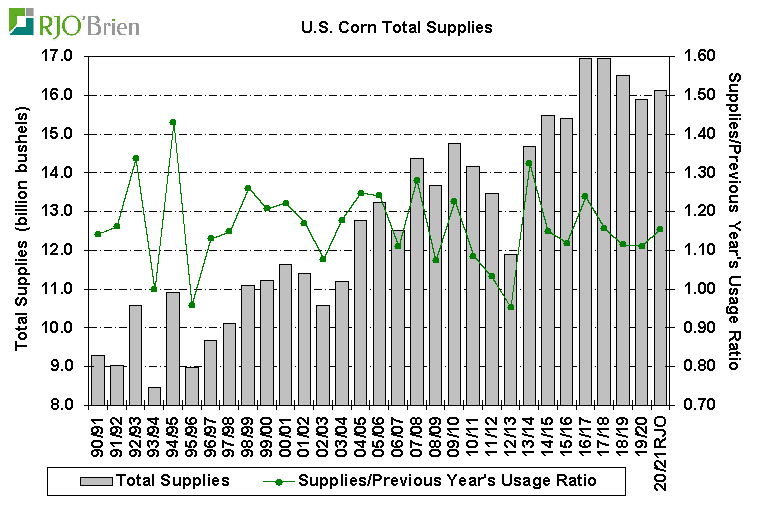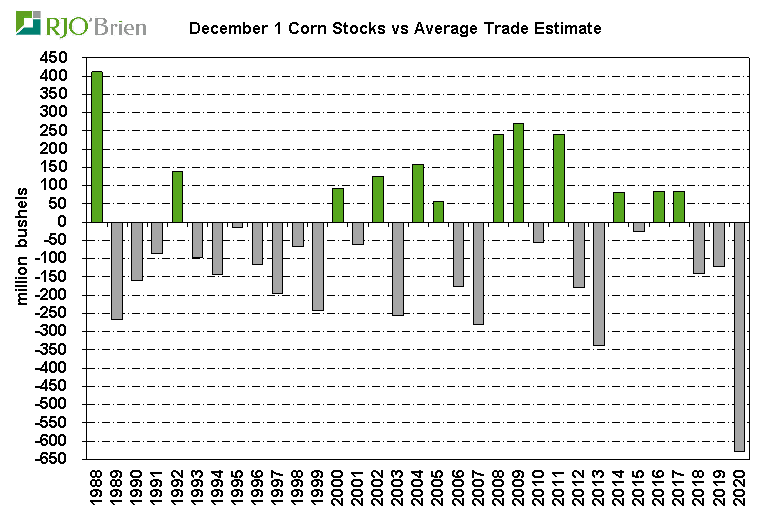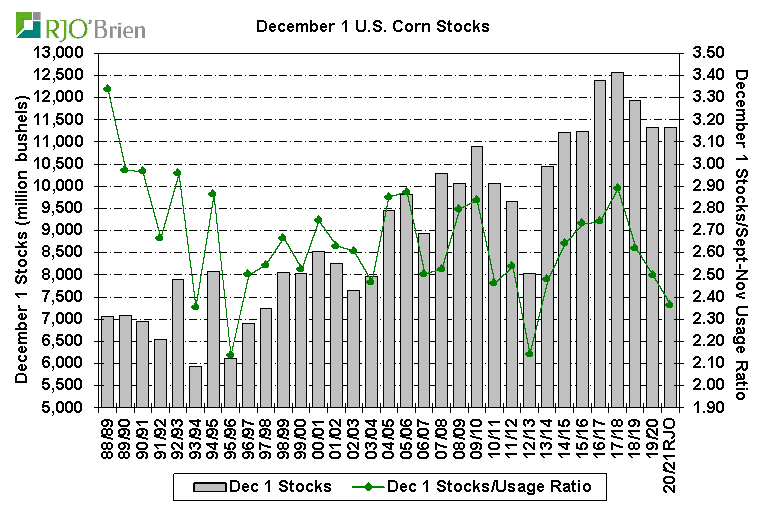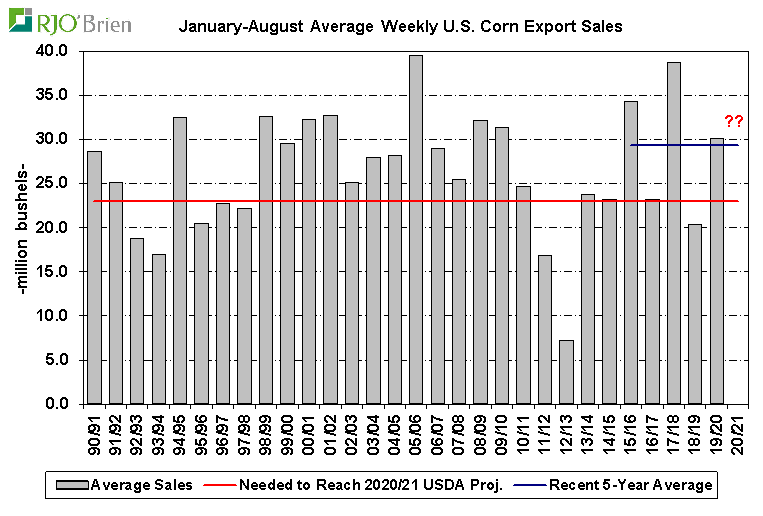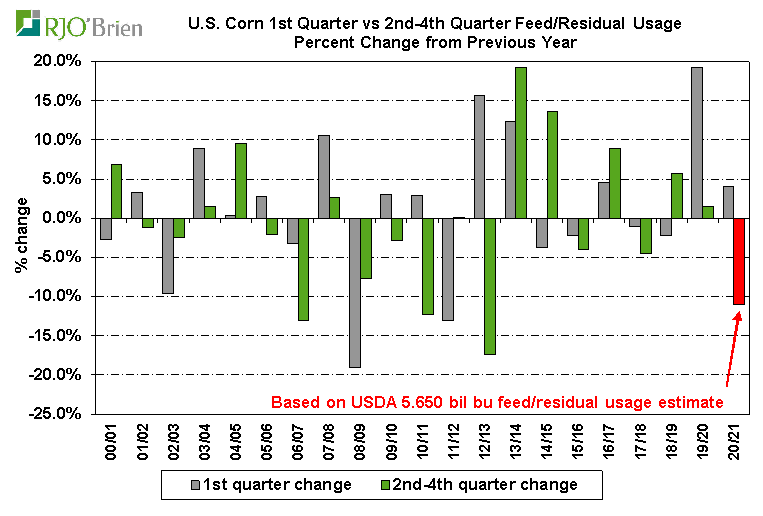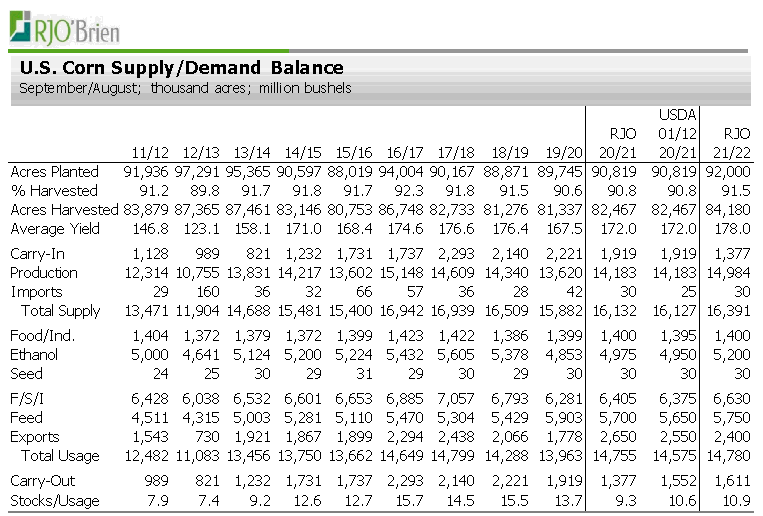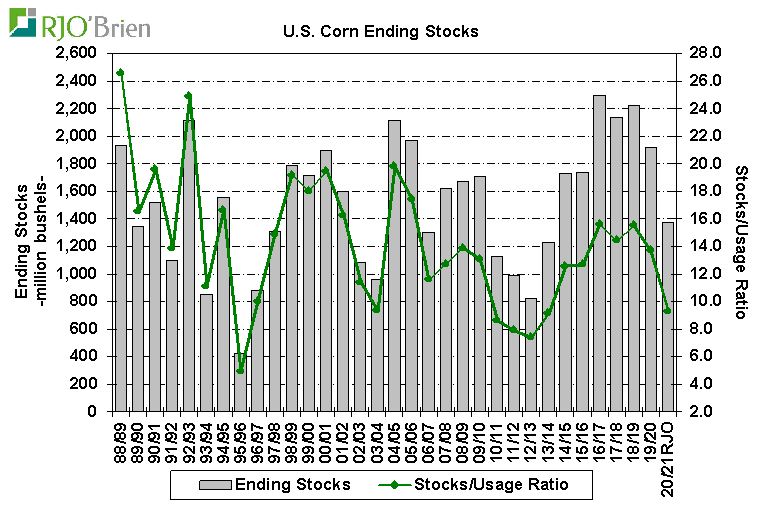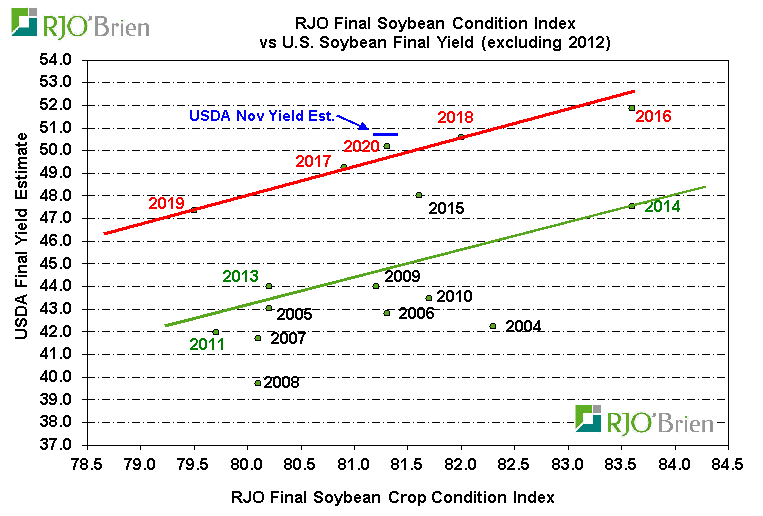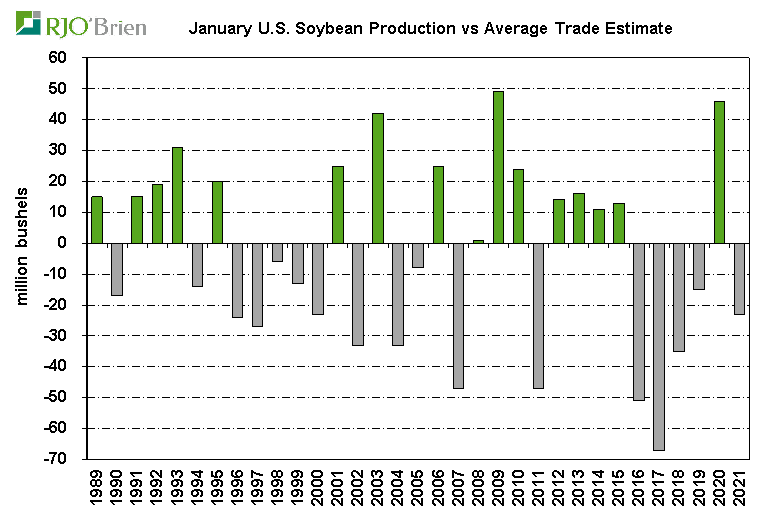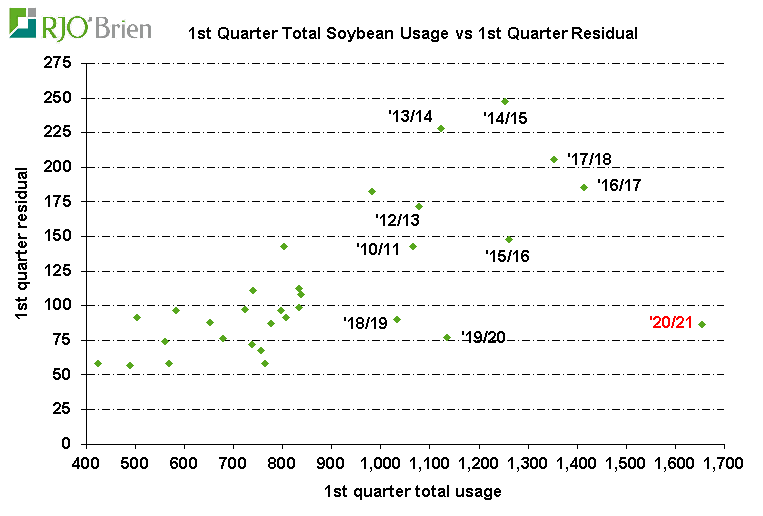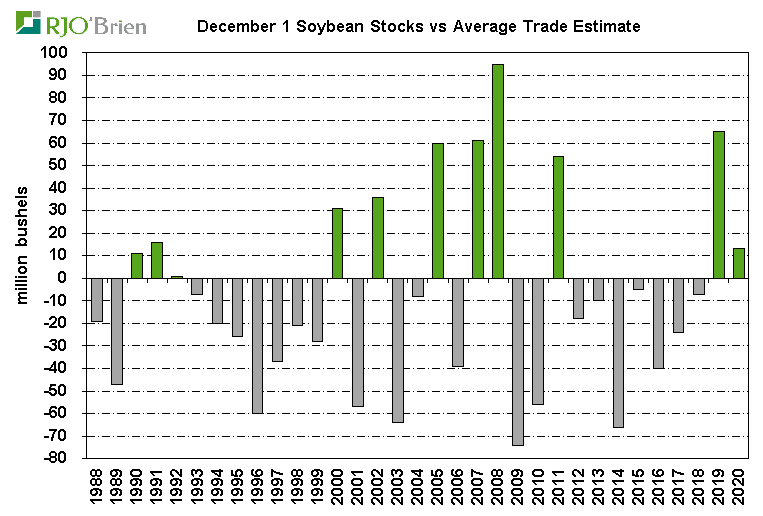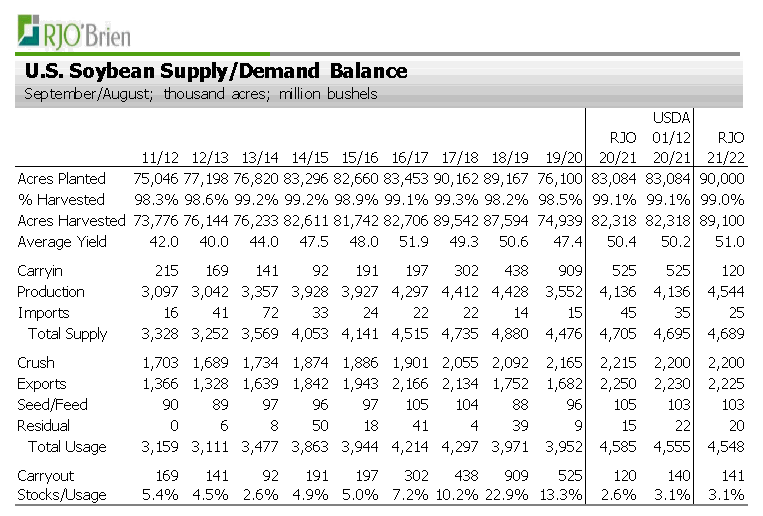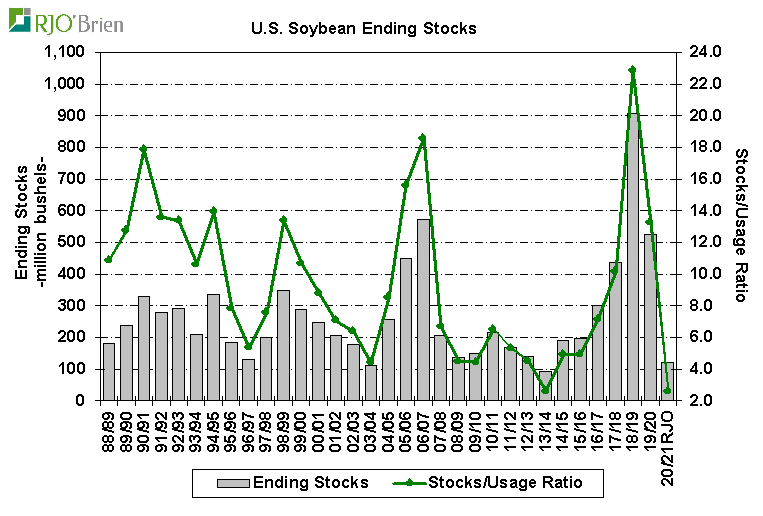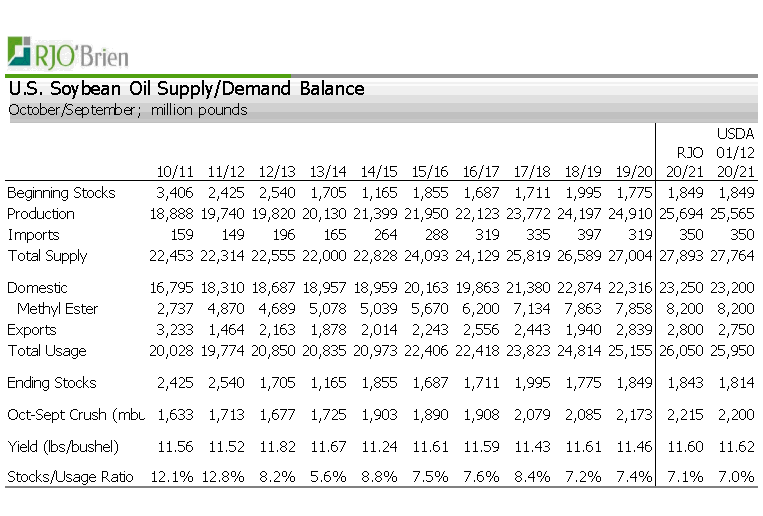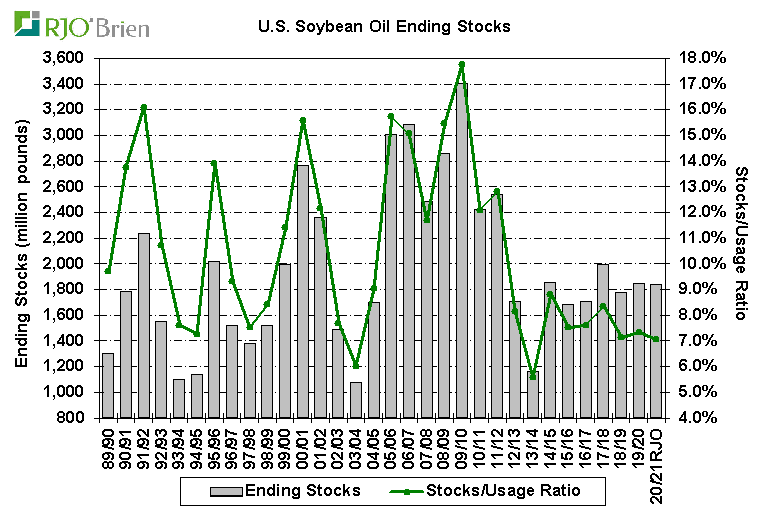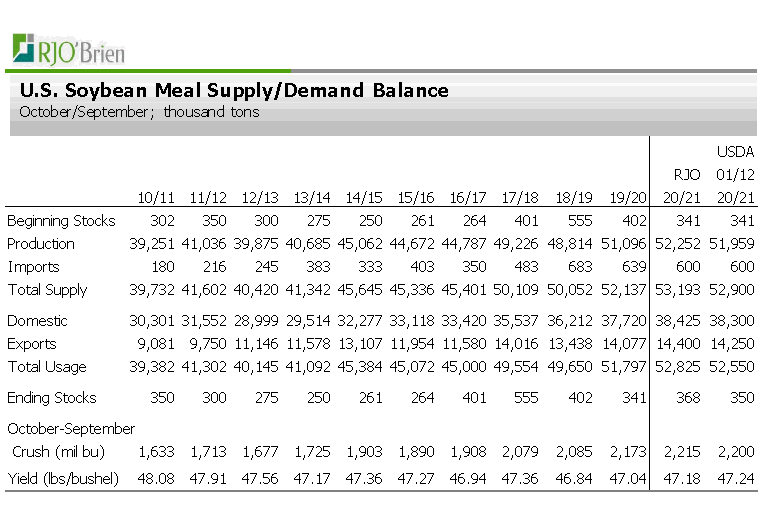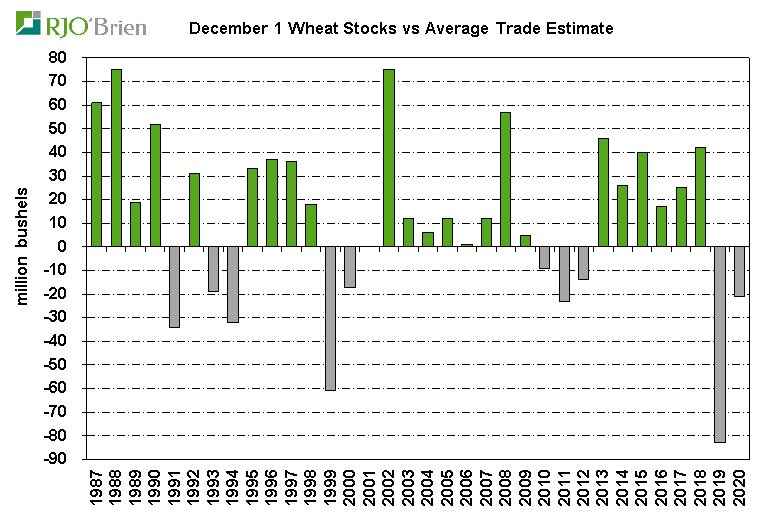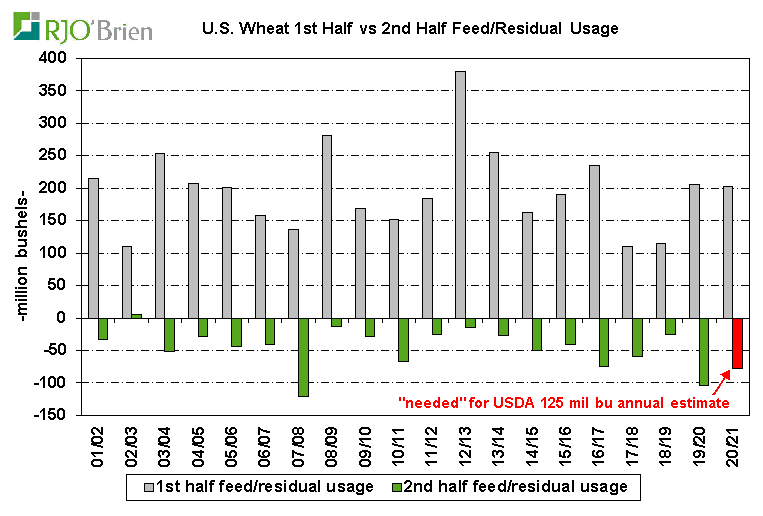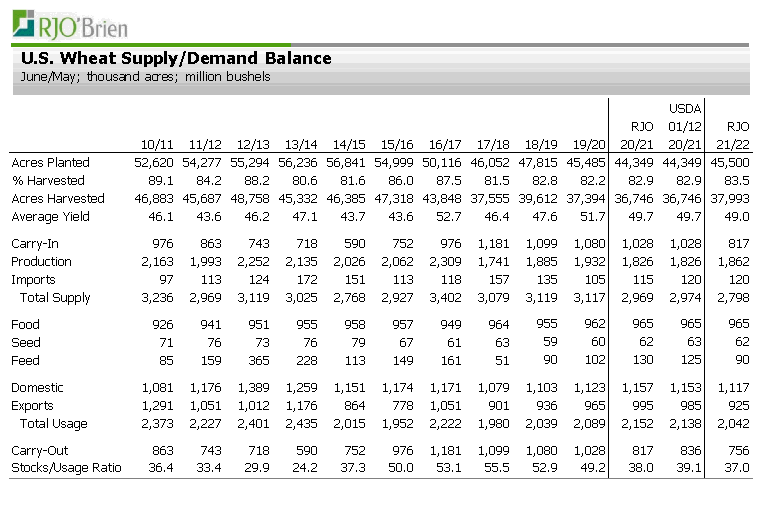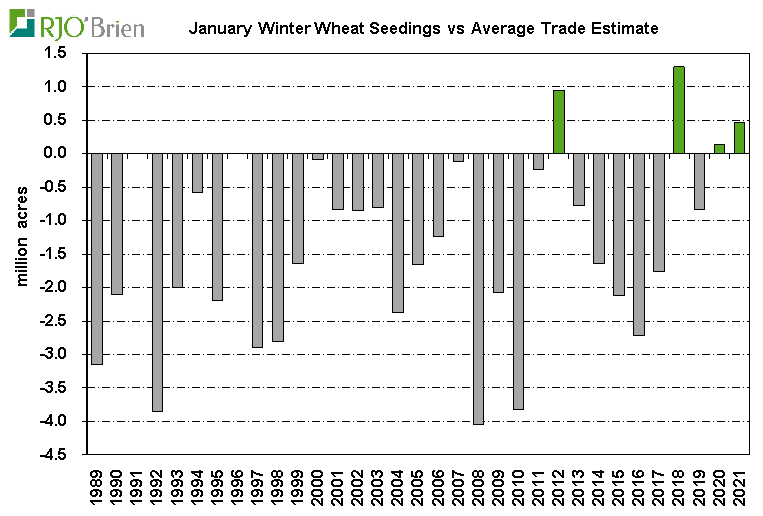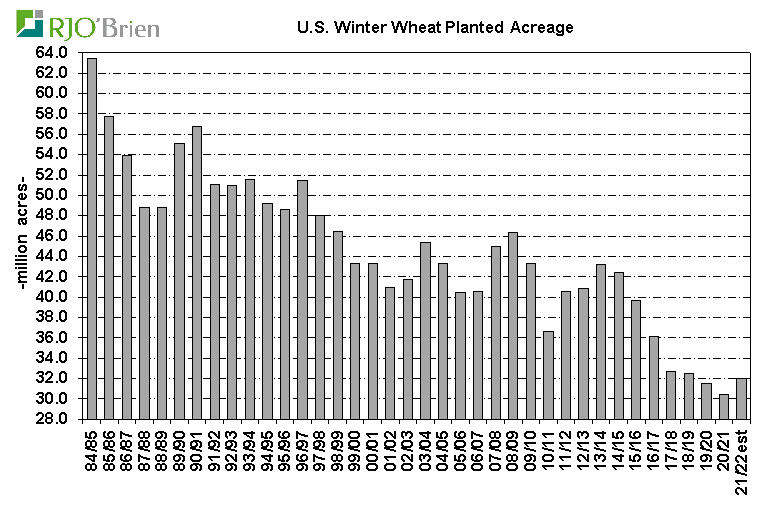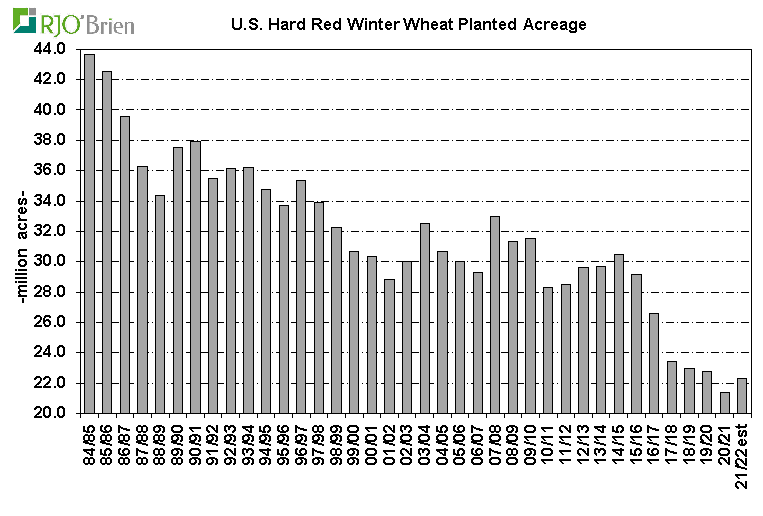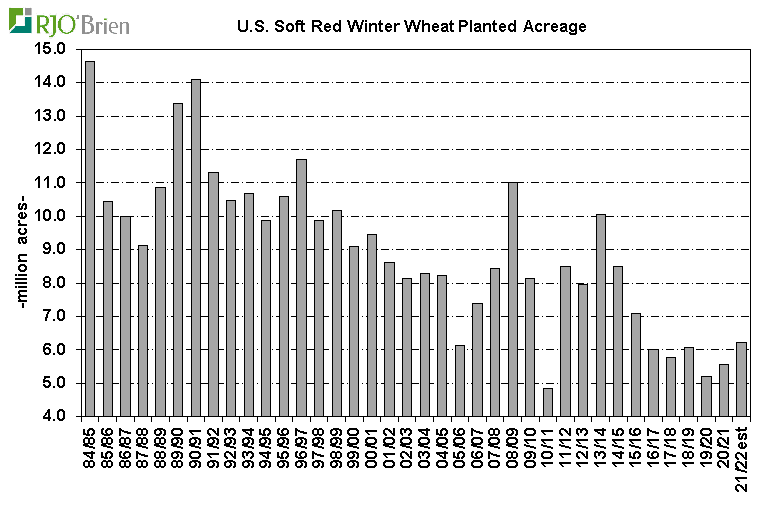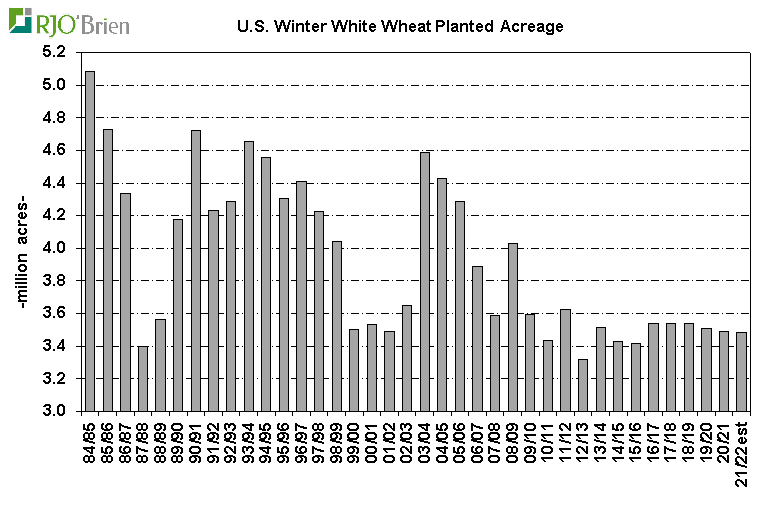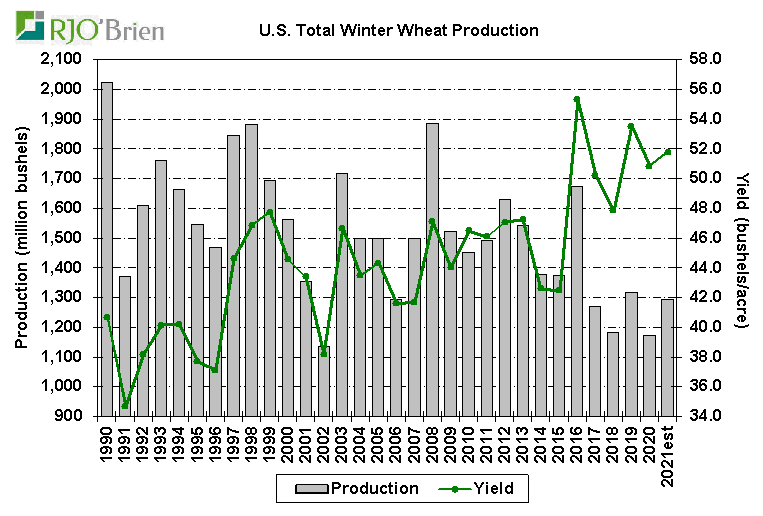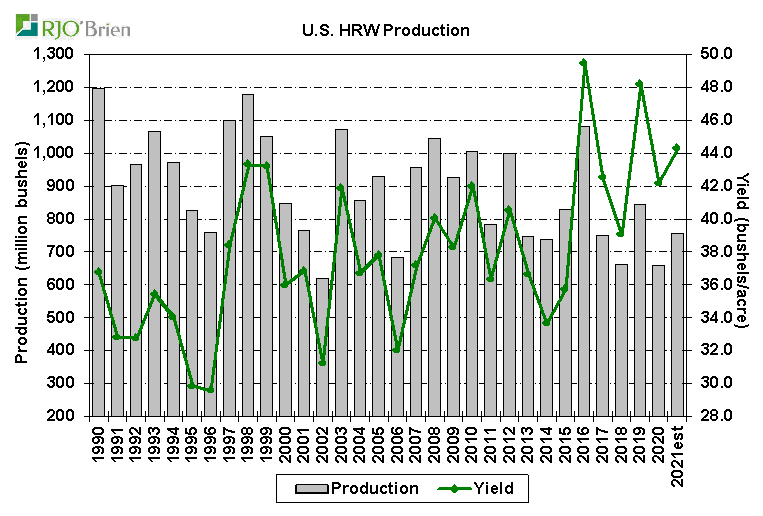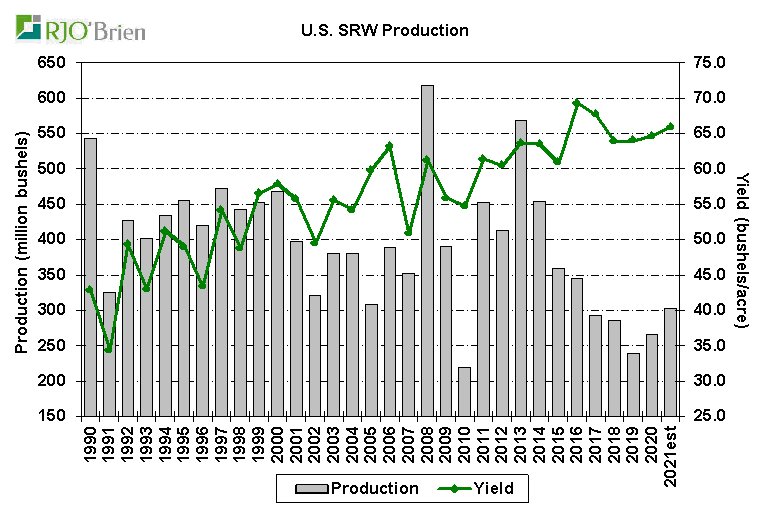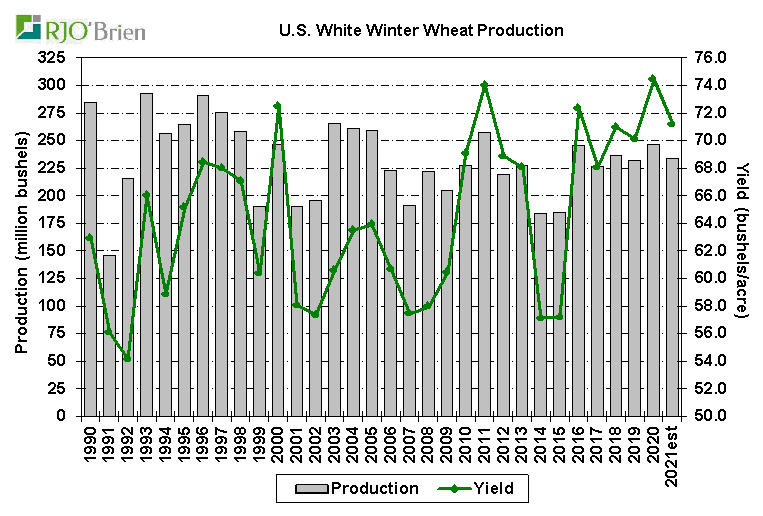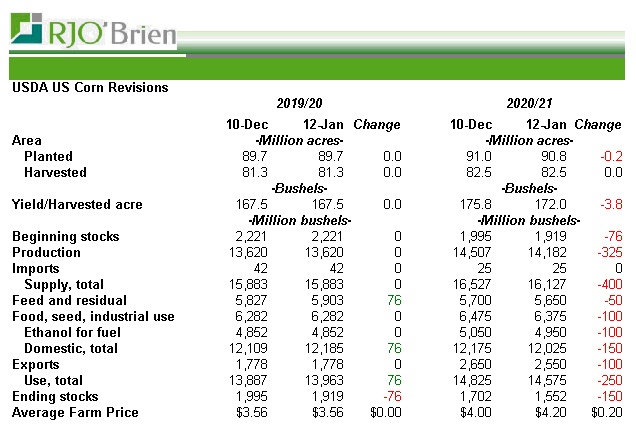Today’s USDA reports provided game-changing numbers for corn, with record-large surprises issued in the Annual Crop Production report and the quarterly Grain Stocks report, while USDA updates confirmed expectations for historically low U.S. soybean stocks for 2020/21. While the same cannot be said for wheat, it went along for the ride, as well, with corn posting limit up gains and soybeans sharply higher.
A summary of key report numbers relative to market expectations is attached to this post as a PDF file.
Corn
Today’s USDA reports provided the classic double-whammy for corn, firstly with the “final†estimate of the 2020/21 U.S. crop coming in solidly below the average trade estimate, followed by the December 1 corn stocks figure coming in even further below expectations than implied by the production surprise alone. In our opinion, the most important take-away number for corn following today’s reports is that through the first quarter of the marketing year, U.S. corn stocks are sitting 629 million bushels (5.3%) less than “expected†as reflected by the average trade estimate, even below year ago levels and the lowest in five years, while total demand is running at a record pace.
Recapping the 2020/21 U.S. corn crop, USDA estimated final production at 14.182 billion bushels, down 325 million bushels from November, with the average yield at 172.0 bushels/acre, down 3.8 bu/acre from November. Relative to “market expectations,†the crop was 288 million bushels lower than expected, easily the largest “bullish surprise†on record for this report with the final yield coming in 3.3 bu/acre below the average estimate.
While the production cut, in and of itself, is undoubtedly shocking, when we look at final yields relative to crop conditions, today’s revision certainly is justifiable. In years such as these, when USDA is consistently estimating yields solidly above existing relationships with conditions, it is essentially impossible to know whether it will end up being a year where yields actually make the next jump higher or whether the USDA is simply over-estimating yields and they end up proving “as expected†based on recent-year crop condition/yield relationships. The latter ended up being the case this year, resulting in the significant bullish surprise. As seen in the following chart, updated from ones we’ve shown in recent months, the lowering of the U.S. average corn yield to 172.0 bushels/acre puts the 2020/21 final yield within about 2 bu/acre of the relationship established between final crop conditions and final yields over the previous three growing seasons – a fully acceptable modest increase in yields. In this context, the USDA’s prior 175.8 bu/acre yield from the November report clearly appears well out of line.
While we felt there was a decent potential for USDA to further lower harvested acreage, in particular, in today’s final estimate, that wasn’t the case as harvested area was only lowered by a net 60k acres from November, with Iowa actually raised 200k, while planted acreage was lowered 159k from November. The production cut was due entirely to reduced yields as nearly every major-producing state’s yield was lowered, some surprisingly including 10 bu/acre cuts from November in MN and WI, as well as 6 bu/acre cuts in IA, ND and MI and a 3 bu/acre cut in IL.
While minor tweaks in the crop size are still possible down the road, revisions from this point forward are typically quite minimal, leaving U.S. production up 563 million bushels (4.1%) from last year, but still the 2nd lowest of the last five years. Total supplies for 2020/21 of 16.132 billion bushels, though, are up only 250 million bushels from last year, while total demand is currently expected to be up anywhere from 600-800 million bushels year-over-year.
Of greater importance than the lower than expected crop was the shockingly low estimate of December 1 U.S. corn stocks at 11.322 billion bushels, slightly below last year’s 11.327 billion, despite beginning supplies being 250 million bushels above year ago, and coming in a record-shattering 629 million bushels below the average trade estimate of 11.951 billion. This dwarfed the previous record “bullish surprise†for Dec 1 corn stocks of 338 million bushels in the January 2014 report.
The sharply lower-than-expected Dec 1 stocks number was due to multiple factors, with the first being the 288 million bushel bullish surprise of the corn crop. Secondly, USDA again notably revised previous quarterly stocks numbers, lowering September 1 stocks (2019/20 ending stocks) by 75 million bushels to 1.919 billion, an impossible to foresee revision, which prompted old crop feed/residual usage to be revised to 5.903 billion bushels from 5.827 billion bushels previously. Lastly, 1st quarter implied feed/residual usage clearly ended up being larger than expected, as well. Based on the average trade estimates for production and Dec 1 stocks, the “market†was looking for Sept-Nov feed/residual usage of around 2.475 billion bushels, down roughly 6% from last year’s 2.634 billion. However, based on all of today’s numbers, 1st quarter feed/residual usage ended up implied at roughly 2.740 billion bushels, up 106 million bushels (4.0% from last year), and a 265 million bushel “surprise.†Adding these three factors together prompted the 600+ million bushel lower than expected Dec 1 stocks figure.
The Dec 1 stocks/Sept-Nov usage ratio of 2.36 is the lowest in eight years and only above the two historically tight years of 2012/13 (eventual ending stocks of 821 million bushels) and 1995/96 (eventual ending stocks of 426 million bushels). Clearly the job of the market is to slow demand from this point forward. The pace of export sales continues to run stronger than “needed†based on USDA annual export projection, while the year-over-year increase in 1st quarter feed/residual usage simply cannot be maintained and hopefully is already slowing with reduced cattle on feed, hogs and pigs and broiler hatch numbers all being reported in recent USDA updates. However, the market is likely to require confirmation of slowing demand through weekly Export Sales numbers, weekly ethanol production numbers, etc., before a top in prices is found.
Turning to the WASDE report, needless to say, the production revision and Dec 1 stocks numbers had profound impacts on the 2020/21 U.S. corn balance sheet. Based on expectations for elevated prices and a clear need to ration demand, USDA cut demand expectations across the board in today’s report.
USDA lowered 2020/21 corn for ethanol usage by 100 million bushels to 4.950 billion, now reflecting on a minor 98 million bushel increase from last year’s massively-reduced COVID-impacted 4.852 billion bushels. USDA also lowered corn exports by 100 million bushels to 2.550 billion in what feels more like a reduction to keep ending stocks “manageable†vs a reduction based on actual demand. While a slowdown in demand for U.S. corn would normally be expected with sharply rising prices, we must keep in mind a considerable portion of the sharply higher demand for U.S. corn this year is due to China, where domestic prices in many/most areas are well above $10.00/bushel, still leaving U.S. supplies quite “cheap†in comparison. Based on today’s USDA export estimate reduction, corn export sales will only need to average around 23 million bushels/week through the end of the marketing year vs last year’s 30.2 million/week average from this point forward and the most-recent 5-year average of 29.4 million/week. Moreover, the current “needed†sales pace would be the 2nd lowest of the last eight years and 4th lowest of the last 24 years to put some perspective on the demand rationing need at hand. We’re maintaining our 2020/21 export projection above USDA at 2.650 billion bushels.
While the need to slow export demand appears significant, it pales in comparison to that of feed/residual usage. Again, based on today’s various numbers, 1st quarter feed/residual usage was implied at roughly 2.740 billion bushels, up 4.0% (106 million bushels) from last year and considerably higher than expected based on the average trade estimates heading into today’s report. Despite this, USDA lowered 2020/21 feed/residual usage by 50 million bushels to 5.650 billion on the need to ration demand rather than demand itself. In order for feed/residual usage this year to not exceed the USDA’s new estimate, 2nd-4th quarter combined feed/residual usage would need to be down 11% (360 million bushels) from last year at 2.910 billion bushels. There have only been a handful of years in which 2nd-4th quarter feed/residual usage decline by 10%+ from the previous year, with 2012/13 being the last. Clearly the task at hand is substantial, indicating prices can ill-afford any prolonged periods of setbacks sending the wrong signals to feed users. While feed rationing is expected, we’re less optimistic than USDA, leaving our estimate at 5.700 billion bushels for now.
The net impact on the 2020/21 U.S. corn balance sheet from today’s reports was a 150 million bushel reduction in ending stocks by USDA to 1.552 billion bushels from 1.702 billion in December in what would easily be the lowest since 2013/14 stocks of 1.232 billion bushels. The average trade estimate of 1.621 billion bushels reflected an expected stocks decline of 81 million bushels from last month. The USDA’s stocks/usage ratio estimated declined to 10.6% and compares to last year’s 13.7% and, again, the lowest since 2013/14. Based on our higher demand expectations, though, we estimate 2020/21 U.S. corn ending stocks at 1.377 billion bushels with a stocks/usage ratio of 9.3%, dropping below the psychologically “rallying call†of 10% – signaling the need to maintain elevated price levels in order to slow demand.
In 2013/14, with ending stocks of 1.232 billion bushels (9.2% stocks/usage), nearby corn futures trade mostly in $4.25-$5.25 price range. In 2012/13, with ending stocks of 821 million bushels (7.4% stocks/usage) and estimated by USDA at only 602 million bushels in the January WASDE report, nearby corn traded mostly in a $6.25-$7.25 during January-May 2013 for reference. It is clear prices currently above $5.00 are justified based on past similar years, the strong demand so far and definitive need to slow demand moving forward.
Globally, USDA lowered the Argentine corn crop 1.5 MMT to 47.5 MMT (51.0 MMT last year) and Brazilian crop by 1.0 MMT to 109.0 MMT (102.0 MMT last year), and further raised Chinese imports by 1.0 MMT, now at 17.5 MMT vs 7.6 MMT last year. Future developments in South American crop prospects will be critical to how export demand for U.S. corn plays out in the 2nd half of the marketing year.
Soybeans
While not nearly as shocking as in corn, today’s USDA soybean numbers were fundamentally supportive, as well. USDA lowered the U.S. soybean crop by 35 million bushels to 4.135 billion, slightly below the average trade estimate of 4.158 billion, while the average yield declined to 50.2 bushels/acre from 50.7 estimated in November and the average trade estimate of 50.5 bu/acre. Planted and harvested acreage figures were hardly changed, while yields declined in most major-producing states by 1-2 bushels/acre, the exceptions being IL and MO with 1 bu/acre increases from November. The yield reduction to 50.2 bushels/acre put the 2020 final yield better in line with the relationship between final crop conditions and yields of recent years than previously estimated by USDA.
USDA reported December 1 U.S. soybean stocks at 2.933 billion bushels, which was actually slightly above the average trade estimate of 2.920 billion bushels, but still down considerably from last year’s 3.252 billion. We would note, though, Dec 1 soybean stocks were higher than we anticipated as we were looking for the 1st quarter residual to prove closer to those of 2016/17 and 2017/18 based on the record demand so far, but that did not prove to be the case, coming in at only 87 million bushels, essentially right in line with those of the last two years despite demand and supplies being significantly larger this year. Perhaps we simply need to start assuming the 1st quarter residual will be 75-100 million bushels regardless of any other fundamental factors at hand.
Despite the lack of any “blockbuster†numbers for soybeans, the 2020/21 balance sheet remains exceptionally tight. USDA could not ignore the record export sales pace and record crush pace, being forced to raise both despite ending stocks ideas being pushed towards historical lows. USDA raised U.S. soybean exports by 30 million bushels to 2.230 billion and crush by 5 million to 2.200 billion, both of which we still feel could very well be too low. As with corn, the final look of the 2020/21 balance sheet will come down to what prices do from here and South American production. For now, we feel exports and crush are both likely to prove higher than USDA projections as we’re at 2.250 billion and 2.215 billion bushels, respectively.
USDA finally raised U.S. soybean imports by 20 million bushels to 35 million, while we’re currently at 45 million in our balance sheet, with late marketing year imports likely as in past historically tight years if confirmed as being needed based on fundamental changes between now and then. For reference, record U.S. soybean imports were 72 million bushels in 2013/14 when ending stocks ended up being a mere 92 million bushels (estimated at 170 million in the January WASDE) and were 41 million bushels in 2012/13 with final ending stocks of 141 million bushels (estimated at 140 million in January).
We’re estimating 2020/21 U.S. soybean ending stocks at 120 million bushels with a stocks/usage ratio of 2.6% vs USDA today at 140 million bushels (3.1%) and last year’s 525 million bushels (13.3%). Export sales on the books already represent 90% of the USDA’s annual export projection with 8 months remaining in the marketing year, indicating the export program essentially needs to be shut down from this point forward to not exceed their estimate. Only twice in history have early January sales represented 90% of annual exports, 2013/14 and 2003/04, both years of minimal ending stocks of 92 million and 112 million bushels, respectively. Soybean sales can only average roughly 7 million bushels/week through the end of August in order to not exceed the USDA’s export projection, which would be the lowest in 7 years and 3rd lowest of the last 17 years. The job of the market is clear. It will be very interesting to see how crush demand responds with the notable decline in margins of late. NOPA’s monthly crush data for December will be out on Friday.
For the products, USDA raised 2020/21 soybean oil production by 125 million pounds due to the higher crush, while also raising domestic usage by 200 million pounds, part of which was biodiesel by 100 million pounds. USDA left soybean oil exports unchanged at 2.750 billion pounds and compare to 2.839 billion last year. The net result was a 75 million pound decline in ending stocks to 1.814 billion pounds, now slightly below last year’s 1.849 billion. USDA raised soybean meal production by 250k tons, fully offset by higher exports, now at 14.25 million tons vs 14.077 million last year.
For world numbers, USDA lowered the Argentine soybean crop by 2 MMT to 48.0 MMT (48.58 MMT last year), but left Brazil unchanged for now at 133.0 MMT (126.0 MMT last year). Developments with the Argentine crop will be absolutely critical moving forward in terms of the potential impact on U.S. crush demand. USDA left China’s soybean import estimate unchanged this month at 100.0 MMT (98.5 MMT last year).
Wheat
USDA estimated December 1 U.S. wheat stocks at 1.674 billion bushels, modestly below the average trade estimate of 1.695 billion and down solidly from last year’s 1.841 billion bushels. Sept-Nov (2nd quarter) feed/residual usage was implied at a small negative of -13 million bushels, following last year’s first positive 2nd quarter residual in 34 years, and compared to the prior five years’ 2nd quarter residuals of -30 to -107 million bushels. With first quarter feed/residual usage implied at 215 million bushels, total first half usage of 202 million bushels compares to last year’s 205 million, leaving the 2nd half (Dec-May) total residual needing to be -77 million bushels in order for the USDA’s 2020/21 annual feed/residual of 125 million bushels (up 25 million bushels from last month) to prove accurate. While this would be “less negative†than last year’s -104 million, it would still be the 2nd largest negative 2nd half residual of the last 13 years, creating a bit of a bias for annual feed/residual usage to prove a bit above USDA’s current estimate. In the big picture, though, final feed/residual usage is unlikely to prove materially different than today’s USDA revision, having on a minor impact on the balance sheet in the end.
The only other change to the 2020/21 U.S. wheat balance sheet this month, other than the 25 million bushel increase in feed/residual usage, was a 1 million bushel uptick in seed usage as a result of the Winter Wheat Seedings report. Exports were held steady at 985 million bushels, unsurprisingly, though we’re still a modest 10 million bushels above USDA with total commitments consistently maintain a roughly 10% year-over-year gain vs USDA’s annual export projection reflecting a minor 2% increase from last year. Accordingly, USDA lowered U.S. wheat ending stocks by 26 million bushels from last month to 838 million, while we’re currently at 817 million bushels. The story remains the same for wheat…not nearly the fundamentally strong pictures as in corn and soybeans, but continuing the improvement from years of excessive stocks, allowing prices to shift higher and being supported by the strong gains in other markets. The wheat balance sheet, overall, is middle of the road in terms of historical stocks levels and wheat prices have rebounded over the last several years, accordingly.
The USDA estimated 2021/22 U.S. winter wheat planted acreage at 31.991 million acres, slightly above the average trade estimate of 31.528 million and up from last year’s 30.415 million. After years of consistently coming in below market expectations, three of the last four years’ reports have come in above the average estimate.
The modestly higher than expected acreage was largely due to soft red winter wheat, with USDA estimating this year’s planted area at 6.233 million acres vs 5.564 million last year and 5.884 million “expected.†If it proves accurate, SRW acreage would be the highest in six years. Hard red winter wheat area was estimated at 22.275 million acres, up from 21.362 million last year and slightly above the average estimate of 22.140 million, but still below 2019’s 22.751 million. White winter wheat area was estimated at 3.483 million vs 3.489 million last year and 3.514 million “expected.†A table detailing the state-level by-class winter wheat acreage estimates relative to last year is at the end of this post.
Applying today’s by-class planted acreage estimates to average harvesting percentages and yields of recent years, HRW production of around 758 million bushels vs last year’s 659 million would be implied, SRW of 303 million vs 266 million last year and white winter 234 million vs 246 million last year, for total winter wheat production of 1.294 billion bushels vs 1.171 billion last year.
U.S. Winter Wheat State-Level By-Class Acreage Estimates
USDA Monthly Supply/Demand Balance Sheet Revisions
